

[CnK] Due passi in centro
Questo virtual cache vi porterà, con una breve ma piacevole passeggiata, in tre luoghi molto noti nel centro di Milano, attirando la vostra attenzione su alcuni particolari curiosi che in qualche modo si legano all’origine del nome
"Milano" e che nel tempo sono divenuti simboli della città.
Step 1: il Duomo.
N 45° 27.849 E 009° 11.437
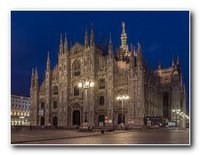
Tutti, sia Milanesi che turisti, conoscono il Duomo di Milano, ma pochi sanno che alla destra del portone centrale, tra le varie decorazioni a tema floreale, si nasconde la statua di quello che sembra essere un dinosauro o un grosso e strano serpente. Si tratta in realtà del drago
Tarantasio, che, secondo la leggenda, viveva nella zona paludosa del
Lago Gerundo, formatosi nella zona est dell’allora Ducato di Milano intorno al 1100, dove ora scorre il fiume Adda.
Secondo la leggenda, Tarantasio viveva nelle profondità della palude e usciva soltanto per catturare i bambini di cui si cibava o per distruggere le barche che disturbavano il suo sonno navigando sulle acque del Gerundo; il suo fiato rendeva l’aria pestilenziale e causava la febbre gialla e, come tutti i draghi che si rispettino, era in grado di sputare fuoco.
Questa leggenda ci riporta a quella che è forse l’etimologia più plausibile per il termine Milano: secondo la maggior parte degli storici, infatti, questo deriverebbe da un’antica parola di origine celtica, Medhelan, che significa “terra di mezzo” o, più precisamente, “luogo in mezzo ai fiumi”. Milano, infatti, sorge tra diversi fiumi che le scorrono attorno e che, ora come in passato, rendono il sottosuolo molto ricco e fertile, grazie anche ai numerosi fontanili presenti nella Pianura Padana. Quando l’esondazione di questi fiumi era continua e prolungata, si creavano zone paludose che spesso venivano infestate da anfibi, insetti e serpenti: è da qui che probabilmente nacque la leggenda di Tarantasio.
Compito:
Farvi una foto (basta una parte del vostro corpo o il GPS) con la scultura del drago Tarantasio.
La foto deve essere simile alla seguente; ogni altra foto (panoramica, piazza, terrazze ecc) NON e' valida.

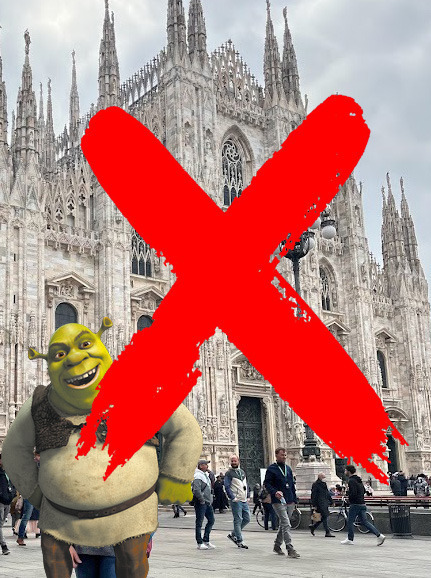
Step 2: Piazza Mercanti.
N 45° 27.893 E 009° 11.281
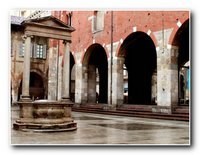
Su quello che una volta era il principale mercato cittadino, di cui ancora conserva il nome, è presente uno dei simboli più noti della città: la
"scrofa semilanuta".
Secondo una delle leggende più diffuse legate alla fondazione di Milano, riportata da Tito Livio e ripresa poi in epoca medioevale, il principe dei Celti
Belloveso, intorno al 600 a.C., conquistò il territorio della Pianura Padana dopo aver sconfitto gli Etruschi che abitavano nella zona. In seguito, volendo fondare una città per consolidare il suo potere, ricevette in sogno (o dalla consultazione di un oracolo, secondo altre versioni) l’ordine divino di seguire una scrofa semilanuta e di fondare la città dove essa si fosse fermata. Dopo aver trovato la scrofa e averla seguita, pose le prime pietre di quella che sarebbe poi diventata la città di Milano, scegliendo come nome quello di
Mediolanum (letteralmente “semilanuto” o “dal pelo medio”) per ricordare la scrofa che gli aveva indicato il punto esatto dove fondare la città.
Nonostante questa sia una delle leggende più note, secondo gli storici è poco probabile che sia quella più adatta a spiegare l’origine del nome di Milano: Mediolanum, infatti, è molto probabilmente la corruzione latina del greco Mediolanon, che a sua volta ricalca un termine più antico in lingua celtica, probabilmente il già citato "Medhelan".
Dietro Piazza Mercanti, invece, si trova un piccolo pozzo, posizionato nel luogo dove un tempo sorgeva la “Pietra dei Falliti”, un masso spigoloso dove chi era colpevole di frode o di bancarotta era costretto a sedere a natiche nude, in attesa della sentenza, esposto al pubblico ludibrio della folla.
Compito:
Farvi una foto (basta una parte del vostro corpo o il GPS) con la scrofa semilanuta oppure con la statua del personaggio molto importante per la storia di Milano. Questa statua si trova in corrispondenza della scrofa semilanuta sul palazzo di fronte.
La foto deve essere simile alle seguenti; ogni altra foto (panoramica, piazza, fontana ecc) NON e' valida.
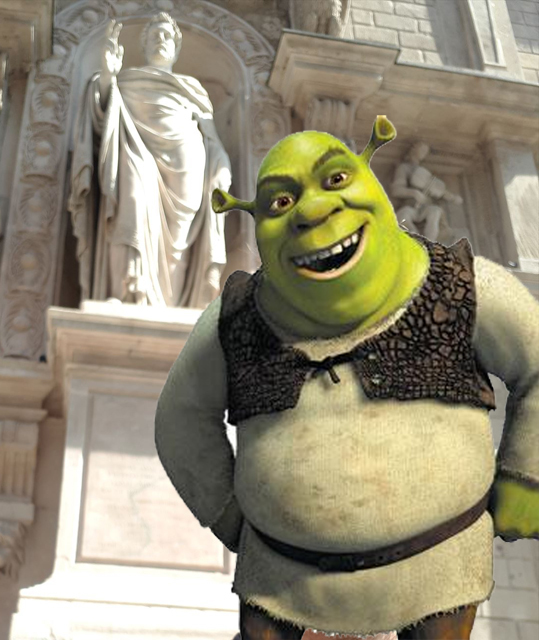

Step 3: il Castello Sforzesco.
N 45° 28.175 E 009° 10.786
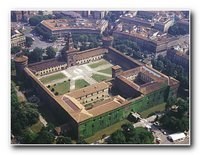
Il
Castello Sforzesco è uno dei luoghi della città più ricchi di quello che era lo stemma della famiglia
Visconti prima e degli
Sforza poi e che ora è uno dei simboli più conosciuti in tutto il mondo legati alla città di Milano: il
Biscione. Siamo in epoca medioevale ormai e la città ha già assunto il nome moderno di Milano, da una corruzione volgare del latino Mediolanum; il governo del Ducato di Milano è da secoli in mano alla famiglia Visconti, poi diventata Sforza, che ha mantenuto il potere per tutta l’età rinascimentale. Lo stemma raffigura un biscione azzurro, coronato, in campo bianco, che tiene in bocca un bambino.
Esso si lega a una leggenda su uno dei capostipiti della famiglia Visconti che, di ritorno dalle Crociate, scoprì che suo figlio era stato mangiato da un grosso serpente che infestava le paludi intorno a Milano. Il Visconti si mise alla ricerca dell’animale, gli fece risputare il figlio, miracolosamente vivo, e lo uccise, liberando la città dalla sua terribile presenza. Gli stessi Visconti raccontavano che il serpentone non era nient’altro che il drago Tarantasio, che il loro antenato era riuscito a uccidere in combattimento. E infatti, nel punto in cui vi trovate, accanto al simbolo del Biscione, è presente anche la bandiera della città di Milano: una croce rossa in campo bianco, meglio nota come
Croce di San Giorgio, noto anch’egli per aver combattuto e ucciso un drago!
Ancora oggi lo stemma col Biscione unito alla bandiera con la Croce di S. Giorgio è uno dei simboli della città di Milano più noti in tutto il mondo, presente anche nei loghi dell’
Alfa Romeo ("Anonima Lombarda Fabbrica Automobili) e dell’
Inter FC (la più importante squadra di calcio della città), due storiche società milanesi.
Compito:
Farvi una foto (basta una parte del vostro corpo o il GPS) con lo stemma.
La foto deve essere simile alla seguente; ogni altra foto (panoramica, torre del filarete, piazza ecc) NON e' valida.
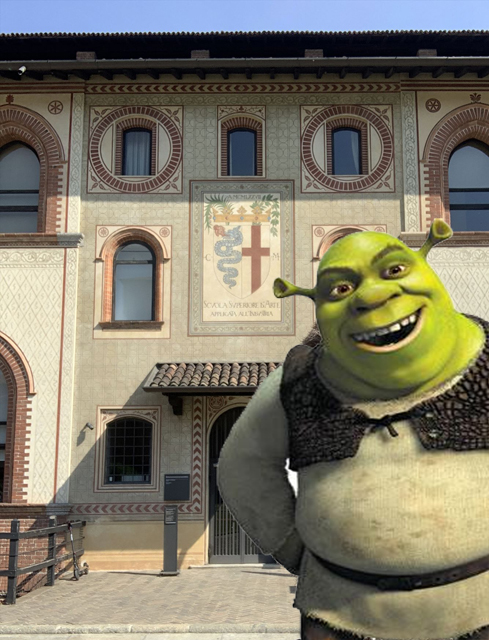
Note sul log del cache:
Trattandosi di un cache virtuale alle coordinate del listing e a quelle dei tre step non troverete alcun contenitore.
Per validare il ritrovamento è obbligatorio inserire all'interno del log le 3 foto che avete fatto nei tre waypoint.
E' importante sottolineare che i log che non conterranno le tre foto o che conterranno tre foto non originali (ad esempio prese dalla rete) saranno cancellati senza alcun avvertimento.
Virtual Reward - 2017/2018
Questo Cache Virtuale è parte di una serie di cache virtuali created tra il 24 Agosto 2017 e il 24 Agosto 2018. Solamente 4.000 proprietario di cache hanno avuto l'opportunità di nascondere un Cache Virtuale. Puoi scoprire qualcosa di più riguardo a questo 'Virtual Rewards' sul Geocaching Blog oppure (in italiano) sul Geocaching Italia Magazine.

Speriamo vi piaccia questo cache e buon divertimento!


[CnK] A short walk in downtown
This virtual cache will take you, with a short but pleasant walk, in three well-known places in the downtown of Milan, attracting your attention to some curious details that somehow bind to the origin of the name "Milan" and that over time have become symbols of the city.
Step 1: il Duomo.
N 45° 27.849 E 009° 11.437
 Everyone, both citizens of Milan and tourists, know the "Duomo", the Cathedral of Milan, but only few know that to the right of the central door, among the various floral-themed decorations, it is hidden the statue of what appears to be a dinosaur or a big and strange snake. It is actually the dragon Tarantasio, which, according to the legend, lived in the marshy area of Lake Gerundo, formed in the east area of what was, at that time, the Ducato di Milano around 1100, where now it flows the Adda river.
Everyone, both citizens of Milan and tourists, know the "Duomo", the Cathedral of Milan, but only few know that to the right of the central door, among the various floral-themed decorations, it is hidden the statue of what appears to be a dinosaur or a big and strange snake. It is actually the dragon Tarantasio, which, according to the legend, lived in the marshy area of Lake Gerundo, formed in the east area of what was, at that time, the Ducato di Milano around 1100, where now it flows the Adda river.
According to legend, Tarantasio lived in the depths of the swamp and went out only to capture the children he fed or to destroy the boats that disturbed his sleep by sailing on the waters of the Gerundo; his breath made the air pestilential and caused the yellow fever and, like all the respectable dragons, he was able to spit fire.
This legend takes us back to what is perhaps the most plausible etymology for the term Milan: according to most historians, in fact, this name would derive from an ancient word of Celtic origin, Medhelan, which means "middle ground" or, more precisely, "place in the middle of the rivers". Milan, in fact, it stands among several rivers that flow around it and which, now as in the past, make the subsoil very rich and fertile, thanks also to the numerous fountains present in the Po Valley. When the flooding of these rivers was continuous and prolonged, marshlands were created that were often infested with amphibians, insects and snakes: this is where the legend of Tarantasio probably originated.
Task:
Take a picture of you (it is sufficient a part of your body or the GPS) with the sculpture of the Tarantasio Dragon.
Please note that photo must be similar as the following one; all other photos (panorama, terrace, etc) are NOT valid.


Step 2: Piazza Mercanti.
N 45° 27.893 E 009° 11.281

On what was once the main market of the city, which still retains its name, there is one of the most famous symbols of the city: the
Scrofa (sow) "semilanuta".
According to one of the most widespread legends related to the foundation of Milan, reported by Tito Livio and then resumed in the Middle Ages, the Prince of the Celts
Belloveso, around 600 bC, conquered the territory of the Po river valley after having defeated the Etruscans who lived in the area. Later, wanting founding a city to consolidate its power, received in the dream (or by consulting an oracle, according to other versions) the divine order to follow a "semilanuta" sow and to found the city where it had stopped. After finding the sow and following it, he laid the first stones of what would then become the city of Milan, choosing as a name
Mediolanum (literally "semilanuto" or "medium hair") to remember the sow that had indicated to him the exact point where to found the city.
Although this is one of the most famous legends, according to historians it is very unlikely that it is suitable to explain the origin of the name of Milan: in fact, Mediolanum is most likely the latin language corruption of the greek "Mediolanon", which in turn follows an older term in the Celtic language, probably the aforementioned "Medhelan".
Interesting thing: behind Piazza Mercanti there is a small well, located in the place where once stood the "Stone of the Failed". This was an angular boulder where whoever was guilty of fraud or bankruptcy was forced to sit naked while waiting for the sentence, exposed to public ridicule of the crowd.
Task:
Take a picture of you (it is sufficient a part of your body or the GPS) with the "semilanuta" sow or with the statue of a very important character for the history of Milan. This statue is located in correspondence of the the "semilanuta" sow on the opposite building.
Please note that photo must be similar as the following ones; all other photos (market, piazza, fountain, etc) are NOT valid.


Step 3: il Castello Sforzesco.
N 45° 28.175 E 009° 10.786

The
Sforzesco Castle (Castello Sforzesco) is one of the richest places in the city of the coat of arms of the
Visconti family and (after) of the
Sforza. Now is one of the most well-known symbols in the whole world related to the city of Milan: the
Biscione.
We are now in medieval historical period and the city has already taken the modern name of Milan, from a vulgar corruption of the Latin Mediolanum; the government of the "Ducato of Milan" has been controlled and owned by the Visconti family for centuries and later it became managed and owned by the Sforza family, who retained power throughout the Renaissance period. The coat of arms depicts a blue, crowned "biscione" (
a big snake), on a white field, holding a baby in the mouth.
This is linked to a legend regarding one of the founders of the Visconti family. On his return from the Crusades he discovered that his son had been eaten by a big snake that infested the swamps around Milan. The Visconti went in search of the animal, made him 'spit' his son that was miraculously alive and then he killed him, freeing the city from his terrible presence. The Visconti themselves said that the big snake was nothing but the dragon Tarantasio, that their ancestor had managed to kill in combat. And in fact, at the point where you are, next to the symbol of the "Biscione", there is also the flag of the city of Milan: a red cross in the white field, better known as
Cross of St. George (Croce di San Giorgio), also known for having fought and killed a dragon!
Even today the coat of arms with the Biscione is mixed with the flag with the Cross of St. George is one of the most famous symbols of the city of Milan all around the world. For example it is present in the logos of the
Alfa Romeo (car producer) and the
Inter FC (most important team of the city) that are two historic companies from Milan.
Task:
Take a picture of you (it is sufficient a part of your body or the GPS) with the emblem.
Please note that photo must be similar as the following one; all other photos (market, piazza, fountain, etc) are NOT valid.

Notes for logging the cache:
Since it is a virtual cache there is no container on the listing coordinates and at the coordinates of all the tree steps.
To validate the finding it is required to post in the log the 3 photo that you have taken at the three waypoints.
It is important to underline that the logs not containing the 3 photos or that contains not original photos (i.e.: taken from the web) will be deleted with no warnings.
Virtual Reward - 2017/2018
This Virtual Cache is part of a limited release of Virtuals created between August 24, 2017 and August 24, 2018. Only 4,000 cache owners were given the opportunity to hide a Virtual Cache. Learn more about Virtual Rewards on the Geocaching Blog.

We hope you'll enjoy your cache and have fun!